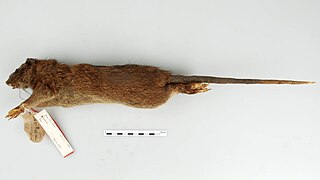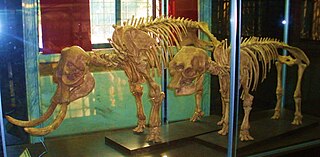
Flores is one of the Lesser Sunda Islands, a group of islands in the eastern half of Indonesia. Including Komodo Island off its west coast, the land area is 15,530.58 km2, and the population was 1,878,875 in the 2020 Census ; the official estimate as at mid 2022 was 1,919,395. The largest towns are Maumere and Ende. The name Flores is the Portuguese and Spanish word for "Flowers".

Sulawesi, also known as Celebes, is an island in Indonesia. One of the four Greater Sunda Islands, and the world's eleventh-largest island, it is situated east of Borneo, west of the Maluku Islands, and south of Mindanao and the Sulu Archipelago. Within Indonesia, only Sumatra, Borneo, and Papua are larger in territory, and only Java and Sumatra have larger populations.

Homo floresiensis( also known as "Flores Man") is an extinct species of small archaic human that inhabited the island of Flores, Indonesia, until the arrival of modern humans about 50,000 years ago.

Stegodon is an extinct genus of proboscidean, related to elephants. It was originally assigned to the family Elephantidae along with modern elephants but is now placed in the extinct family Stegodontidae. Like elephants, Stegodon had teeth with plate-like lophs that are different from those of more primitive proboscideans like gomphotheres and mammutids. The oldest fossils of the genus are found in Late Miocene strata in Asia, likely originating from the more archaic Stegolophodon, shortly afterwards migrating into Africa. While the genus became extinct in Africa during the Pliocene, Stegodon remained widespread in South, Southeast and East Asia until the end of the Pleistocene.

Dwarf elephants are prehistoric members of the order Proboscidea which, through the process of allopatric speciation on islands, evolved much smaller body sizes in comparison with their immediate ancestors. Dwarf elephants are an example of insular dwarfism, the phenomenon whereby large terrestrial vertebrates that colonize islands evolve dwarf forms, a phenomenon attributed to adaptation to resource-poor environments and lack of predation and competition. Some modern populations of Asian elephants have also undergone size reduction on islands to a lesser degree, resulting in populations of pygmy elephants.

Papagomys is a genus of very large rats in the tribe Rattini of the subfamily Murinae, with body masses of 600–2,500 grams (1.3–5.5 lb). It contains two species, which are known only from the Indonesian island of Flores:

Liang Bua is a limestone cave on the island of Flores, Indonesia, slightly north of the town of Ruteng in Manggarai Regency, East Nusa Tenggara. The cave demonstrated archaeological and paleontological potential in the 1950s and 1960s as described by the Dutch missionary and archaeologist Theodor L. Verhoeven.

Insular dwarfism, a form of phyletic dwarfism, is the process and condition of large animals evolving or having a reduced body size when their population's range is limited to a small environment, primarily islands. This natural process is distinct from the intentional creation of dwarf breeds, called dwarfing. This process has occurred many times throughout evolutionary history, with examples including dinosaurs, like Europasaurus and Magyarosaurus dacus, and modern animals such as elephants and their relatives. This process, and other "island genetics" artifacts, can occur not only on islands, but also in other situations where an ecosystem is isolated from external resources and breeding. This can include caves, desert oases, isolated valleys and isolated mountains. Insular dwarfism is one aspect of the more general "island effect" or "Foster's rule", which posits that when mainland animals colonize islands, small species tend to evolve larger bodies, and large species tend to evolve smaller bodies. This is itself one aspect of island syndrome, which describes the differences in morphology, ecology, physiology and behaviour of insular species compared to their continental counterparts.
Theodorus (Theo) Lambertus Verhoeven, SVD, was a Dutch missionary and archaeologist who has become famous by his discovery of stone tools on the Indonesian island of Flores, in association with the c. 800,000-year-old fossils of stegodontids, or dwarf elephants, from which he concluded that islands in Wallacea had been reached by Homo erectus before modern humans appeared there.

Ngada Regency is one of the regencies on the island of Flores, East Nusa Tenggara Province, Indonesia. It is bordered by East Manggarai Regency to the west and Nagekeo Regency to the east, with the Flores Sea to the north and the Sawu Sea to the south. The Regency, which covers an area of 1,620.92 km2, had a population of 142,254 at the 2010 census, which increased to 165,254 at the 2020 census; the official estimate as at mid 2022 was 170,120. The town of Bajawa is the capital of Ngada Regency.

Prehistoric Indonesia is a prehistoric period in the Indonesian archipelago that spanned from the Pleistocene period to about the 4th century CE when the Kutai people produced the earliest known stone inscriptions in Indonesia. Unlike the clear distinction between prehistoric and historical periods in Europe and the Middle East, the division is muddled in Indonesia. This is mostly because Indonesia's geographical conditions as a vast archipelago caused some parts — especially the interiors of distant islands — to be virtually isolated from the rest of the world. West Java and coastal Eastern Borneo, for example, began their historical periods in the early 4th century, but megalithic culture still flourished and script was unknown in the rest of Indonesia, including in Nias, Batak, and Toraja. The Papuans on the Indonesian part of New Guinea island lived virtually in the Stone Age until their first contacts with modern world in the early 20th century. Even today living megalithic traditions still can be found on the island of Sumba and Nias.

Homo luzonensis, also locally called "Ubag" after a mythical caveman, is an extinct, possibly pygmy, species of archaic human from the Late Pleistocene of Luzon, the Philippines. Their remains, teeth and phalanges, are known only from Callao Cave in the northern part of the island dating to before 50,000 years ago. They were initially identified as belonging to modern humans in 2010, but in 2019, after the discovery of more specimens, they were placed into a new species based on the presence of a wide range of traits similar to modern humans as well as to Australopithecus and early Homo.

Elephas hysudrindicus, commonly known also as the Blora elephant in Indonesia, is a species of extinct elephant from the Pleistocene of Java. It is anatomically distinct from the Asian elephant, the last remaining species of elephant under the genus Elephas. The species existed from around the end of the Early Pleistocene until the end of the Middle Pleistocene, when it was replaced by the modern Asian elephant, coexisting alongside fellow proboscidean Stegodon trigonocephalus, as well archaic humans belonging to the species Homo erectus.
Professor Michael John Morwood was a New Zealand archaeologist best known for discovering Homo floresiensis. In 2012, he received the Rhys Jones Medal by the Australian Archaeological Association.

Megalochelys is an extinct genus of tortoises that lived from the Miocene to Pleistocene. They are noted for their giant size, which is among the largest of any known testudine, with a maximum carapace length over 2 m (6.5 ft) in M. atlas. During the dry glacial periods it ranged from western India and Pakistan to as far east as Sulawesi and Timor in Indonesia, though the island specimens likely represent distinct species.
The Trinil H. K. Fauna, or Trinil Haupt Knochenschicht Fauna is a biostratigraphic faunal assemblage. It is another interpretation of the collection of fossils gathered by Eugène Dubois at Trinil, where he discovered the early hominid fossils of Java Man. It was proposed in the 1980s a group of Dutch paleontologists to reassess the date of the layer in which Java Man was found.

The region of Southeast Asia is considered a possible place for the evidence of archaic human remains that could be found due to the pathway between Australia and mainland Southeast Asia, where the migration of multiple early humans has occurred out of Africa. One of many pieces of evidence is of the early human found in central Java of Indonesia in the late 19th century by Eugene Dubois, and later in 1937 at Sangiran site by G.H.R. van Koenigswald. These skull and fossil materials are Homo erectus, named Pithecanthropus erectus by Dubois and Meganthropus palaeojavanicus by van Koenigswald. They were dated to c. 1.88 and 1.66 Ma, as suggested by Swisher et al. by analysis of volcanic rocks.

The Nesher RamlaHomo group are an extinct population of archaic humans who lived during the Middle Pleistocene in what is now modern-day Israel. In 2010, evidence of a tool industry had been discovered during a year of archaeological excavations at the Nesher Ramla site. In 2021, the first Nesher Ramla Homo individual was identified from remains discovered during further excavations.
Varanus hooijeri is an extinct species of medium-sized monitor lizard found in Liang Bua on Flores and possibly also Sumba, dating to the Late Pleistocene and Holocene.

Stegoloxodon is an extinct genus of dwarf elephant known from the Early Pleistocene of Indonesia. It contains two species, S. indonesicus from Java, and S. celebensis from Sulawesi. Its relationship with other elephants is uncertain.
















